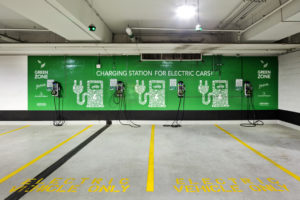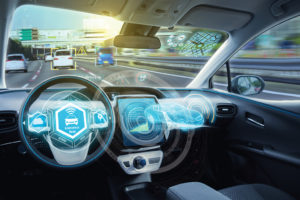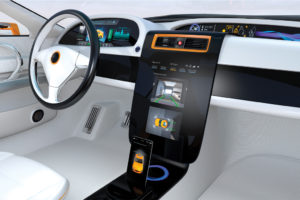Simon Fraser University’s experience implementing a new parking revenue stream.
By David Agosti
Simon Fraser University’s (SFU) main campus is located in Burnaby BC. SFU has over 5,000 parking spaces and EV Chargers has been part of their parking supply since 2012. Starting in 2021 (post-COVID) SFU has been expanding their EV Charging network in order to provide a service to customers, assist governments in their EV Charging goals, and provide an additional revenue source to the University.
Some EV Charging Basics
As the world of EV Charging evolves it is helpful to understand some of the basic terminology:
- Port – the part of the EV Charger that supplies power to the electric vehicle via a cable and charging head. Some EV Chargers have one port (can charge 1 car), and some have two.
- Level 1 Charger – slowest form of charging utilizing a 110V outlet. Normally to use a Level 1 charger the driver needs their own cable and charging head that was supplied with the car.
- Level 2 Charger – a mid-speed form of charging using AC power varying from 7KWH to 19KWH depending on model. Most Level 2 chargers have 2 ports.
- DCFC (Level 3) Charger – the fastest form of charging using DC power varying from 50KWH – 350KWH depending on model. DCFC’s fill an EV batter to approx. 90% charge after which they provide a trickle charge so as not to damage the battery.
- KWH – Kilowatt-Hour – EV Charger speeds as well as EV battery capacity are measured in KWH.
- LCFS – Low Carbon Fuel Standard – in BC (and some US States) a program that aims to reduce the carbon intensity of transportation fuels. Clean fuel…
Brendan McEwen – Director, Electric Mobility & Low Carbon Strategies, AES Engineering Ltd.
Over the next two decades, Canadian cities will experience a profound transition from transportation systems dominated by personal vehicles with combustion engines to electric mobility systems. “Electric mobility” encompasses personal electric vehicles (EVs), electric transit, e-bikes, car-sharing, ride-hailing, ride-sharing, and perhaps one day, autonomous robo-taxis. Parking professionals have a crucial role to play in speeding the transition to electric mobility, realizing the benefits that it can provide to their communities and to parking authorities’ bottom line.
The transition to electric mobility will provide financial, safety and quality of life benefits for all members of our community. Depending on where you are in Canada, EVs typically cost 65% to 80% less to fuel than comparable internal combustion vehicles. Likewise, Consumer Reports recently published data confirming that EVs have half the maintenance cost of conventional vehicles. All told, Canada’s 2 Degrees Institute estimates that the average Canadian EV driver will save $27,000 in fuel and maintenance costs over a 10-year operating life.
EVs still currently have higher initial costs than conventional vehicles, due to the cost of batteries. However, battery costs are declining rapidly – industry average lithium-ion battery costs have reduced from approximately $1200/kWh of battery capacity in 2010, to $156/kWh in 2019. Average battery costs are projected to decline to $100/kWh by about 2024, at which point there will be no price premium for EVs. Indeed, Elon Musk recently described how Tesla can achieve costs of approximately $65/kWh in the next three years. Given the improvements in battery technology and manufacturing, sources as diverse as the Canadian Vehicle Manufacturers Association, International Council on Clean Transportation, and Bloomberg New Energy Finance agree that battery cost reductions…
By Mark Hutchinson, Vice President of Green Building Programs, Canada Green Building Council
The changing nature of the parking and transportation industry has highlighted the importance of understanding the sector’s environmental impact and its key role in mitigating climate change. Among those leading the charge in this area is the Yorkdale Shopping Centre in Toronto’s North York area, which has been no stranger to innovative new initiatives throughout its 50-year history, including a number of sustainability efforts as part of its green program.
In July 2018, the mall achieved Parksmart certification at the Pioneer level for existing parking structures by obtaining more than 90 points for its G Parkade southwest parking garage, and in August, Yorkdale’s newly constructed E Parkade east structure certified Parksmart Bronze by achieving between 110 and 134 points. These are the first Parksmart certified projects in Canada – and the first retail certifications in the world.
The Parksmart rating system is administered in Canada by GBCI Canada, which is jointly-owned by the Canada Green Building Council (CaGBC) and Green Business Certification Inc. (GBCI). Designed to advance sustainable mobility through smarter parking structure design and operation, Parksmart helps parking structure owners and managers ensure their assets are future-proof and functioning optimally in order to maximize operational savings.
For both Yorkdale projects, the Parksmart certification process has served to highlight opportunities to maximize and modernize parking assets, ensure strong returns on investment, and provide an enhanced parking experience for mall patrons.
Redefining parking as part of a broader green strategy
Yorkdale has had green initiatives in place for more than two decades, from being one of the first shopping centres in Canada to implement a recycling program, to more recent measures such as the utilization of reusable tableware and cutlery, organics composting and an urban…
By Danielle Desjardins
We are on the brink of a revolution, a revolution that will profoundly affect society, change the way cities look and function and fundamentally transform how people and goods move.
It’s been dubbed the “driverless revolution” and it will be brought about by the advent of autonomous cars (AV), cars that drive themselves with little or no human intervention. In addition to their effect on modes of transport, AVs are poised to disrupt many industries: fast food, real estate, hotels, airlines — large industries that will have to shift their strategies in the wake of driverless cars.
The biggest disruption could be on parking. Among other innovations the revolution will bring, we will see AV fleets moving continuously between the various places they are needed, rendering the need for close and convenient parking spaces much less necessary.
Ready for the driverless revolution?
In the last issue, we discussed the potentially impending driverless revolution and the impact it could have on the parking industry1. In the envisioned driverless society, fully automated vehicles (AVs) would drop their passengers at their destination, go home to park or return in the transportation network while awaiting their next ride and the parking industry would be massively disrupted.
To some, the driverless revolution is already be upon us and our roads will be overtaken by robocars within the next five to ten years. Is this belief shared by the people involved in parking and are they getting ready for it?
In need of a crystal ball
Although all those interviewed for this article believe AVs will eventually rule our roads, some also believe that the revolution will be a long time coming.
“I don’t see it happening in my lifetime”, states Professor Michel Lejeune, who teaches sociology of technology at École Polytechnique in Montréal. The technology may be outstanding and almost…
By Danielle Desjardins
We are on the brink of a revolution, a revolution that will profoundly affect society, change the way cities look and function and fundamentally transform how people and goods move.
It’s been dubbed the “driverless revolution” and it will be brought about by the advent of autonomous vehicles (AV), cars that drive themselves with little or no human intervention. In addition to their effect on modes of transport, AVs are poised to disrupt many industries: transit, insurance, all industries that currently need drivers, driving support services, and the technology sector — large industries that will have to shift their strategies in the wake of driverless cars.
One major disruption could be on parking. Among other innovations, the revolution will bring, we will see AV fleets moving continuously between the various places they are needed, rendering the need for close and convenient parking spaces much less necessary.
As Alain L. Kornhauser of Princeton University told the online magazine Curbed, “Having parking wedded or close to where people spend time, that’s going to be a thing of the past. If I go to a football game, my car doesn’t need to stay with me. If I’m at the office, it doesn’t need to be there. The current shopping centre with the sea of parking around it, that’s dead.”1
How soon will that revolution begin? A number of car manufacturers predict that AVs will be launched about 2020, with many suppliers focusing first on driverless taxis. RethinkX, a think tank on technology-driven disruption, believes that by 2030 “95% of U.S. passenger miles traveled will be served by autonomous electric vehicles.” 2 Others foresee a clear majority of urbanites not even needing to own cars by 2040, because they’ll subscribe to some form of on-demand self-driving car service.3 McKinsey & Company believe that once technological…







